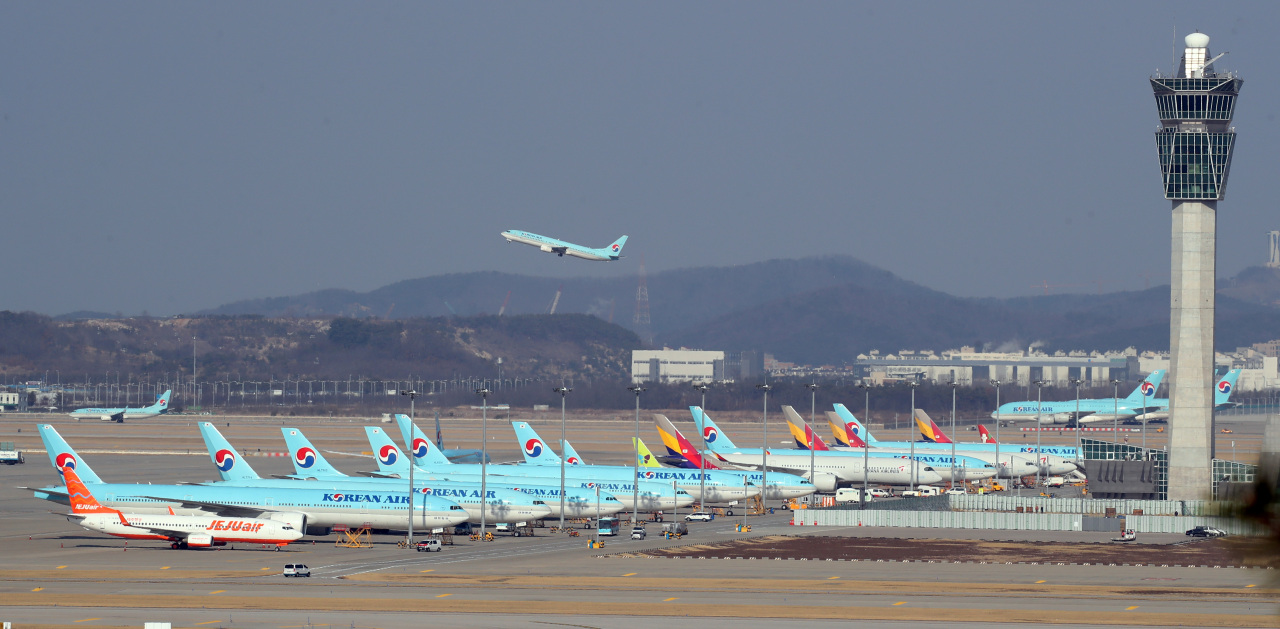 |
Aircrafts are stationed at a parking ramp inside Incheon International Airport. (Yonhap) |
Following a sharp drop in the number of passengers and route suspensions due to spread of COVID-19, South Korean air carriers are flying smaller planes while parking their unused aircrafts within the airport facilities, according to industry sources Wednesday.
Full-service carrier Korean Air said that it would reduce the number of seats on its Incheon-Los Angeles route from 407 to 277 by switching from the A380-8 aircraft to the smaller B777-300 until March 14.
Asiana Airlines has also changed midsized aircrafts for Tokyo and Fukuoka routes to smaller planes such as the A321, the company said.
After more countries announced travel warnings to Korea and entry restrictions for people arriving from the country, domestic air carriers have additionally suspended some services to the US and European countries, after shutting down all or most Chinese and Southeast Asian routes.
Korean Air said Wednesday that it will halt services on four of its 11 US routes until April 25. They account for about 30 percent of its total revenue.
The affected flights include Incheon-Seattle, Incheon-Las Vegas, Incheon-Boston and Incheon-Dallas routes.
It also announced that eight of its 12 European routes will be suspended until March 28.
This has led airlines to park more aircrafts inside the airport.
According to Incheon International Airport Corp., a total of 173 aircrafts have been parked inside the airport as of Monday, even using spaces such as taxiways due to the lack of space.
The airport operator said there were about 130 aircraft on the parking ramp in January, when COVID-19 infection cases were still mostly limited to China.
Market insiders voiced concerns over the prolonged impact of COVID-19 on aviation industry as stationing aircrafts not only costs parking fees but also rent for leased planes.
Korean Air and Asiana Airlines lease 47 percent and 62 percent of their aircrafts, respectively, while low-cost carriers lease almost all of their planes.
“Considering Korean air carriers’ high ratio of leased planes (compared to other flag carriers), it is crucial for them to make a profit on international routes, but the continued impact of COVID-19 makes it difficult to overcome this crisis,” said an industry insider.
By Kim Da-sol (
ddd@heraldcorp.com)




![[Herald Interview] 'Trump will use tariffs as first line of defense for American manufacturing'](http://res.heraldm.com/phpwas/restmb_idxmake.php?idx=644&simg=/content/image/2024/11/26/20241126050017_0.jpg)

![[Health and care] Getting cancer young: Why cancer isn’t just an older person’s battle](http://res.heraldm.com/phpwas/restmb_idxmake.php?idx=644&simg=/content/image/2024/11/26/20241126050043_0.jpg)

